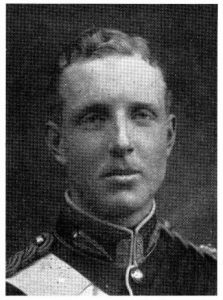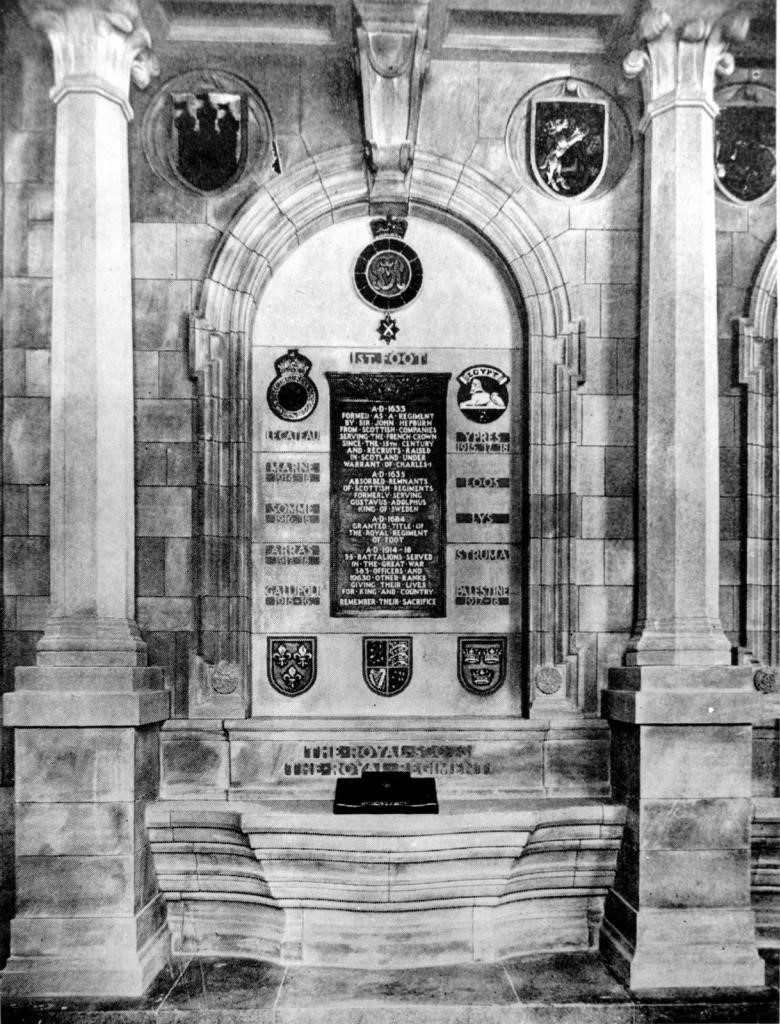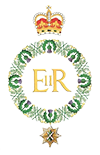THE ROYAL SCOTS (THE ROYAL REGIMENT) IN THE 1st WORLD WAR (WW1)
At the outbreak of war The Royal Scots (RS) consisted of two Regular battalions, the 1st, at, or close to full strength of some 1000 all ranks, in India, and the 2nd, needing reinforcement by some 500 reservists, at Plymouth. The 3rd (Reserve) Regular battalion, the old Militia, based at Glencorse, Penicuik, with a greater training commitment than the new (1908) Territorial Force (TF), had the role of reinforcing the active service Regular battalions. In addition there were seven TF battalions 4RS, whose Drill Hall was at Grindlay Street, opposite the Usher Hall, in Edinburgh, 5RS (Forrest Hill), 6RS (Gilmore Place), 7RS (Dalmeny Street, Leith), 8RS (Haddington and Peebles), 9RS (Highlanders)(East Claremont Street) and 10 RS (Linlithgow). During the course of the war the number of Territorial battalions rose to twenty-two, although that number was not sustained for long, and eight ‘New Army’ battalions and two Garrison battalions were raised. In all a total of thirty five RS battalions served in WW1, more than in any other Scottish Regiment, of which eighteen saw active service. A short description of the service of each of the 35 battalion can be found by clicking on ‘WW1 Battalions‘ partner link.

9th (Highlander) Battalion resting at Leith after mobilisation August 1914
The total regular strength of the Regiment on 4 August 1914 would have been around 2000 all ranks and that of the seven Territorial battalions probably about 5,000, giving a total Regimental strength of some 7,000. By the time of the Armistice on 11 November 1918, over 100,000 men had served with the Regiment. Of these 11,213 (Over 10%) had been killed, including, on 22 August 1914, Lieutenant G M Thompson (below), the first British officer to be killed in action in the war when on secondment commanding a small force of local troops against German forces in West Africa The number killed equates to roughly 1 in 10, or 10%, of all Scotsmen, of whatever arm or unit, killed on all the WW1 battlefields. A staggering percentage from a single regiment. In addition to those killed, over 40,000 were wounded, making a total Royal Scots casualty list of over 50%. For information on how to research the service of a particular individual please see the ‘Help on Research‘ partner link.
For those wishing information on any Royal Scot who died in WW1, you can access The Royal Scots World War 1 Roll of Honour through the Home page and clicking on the link to: The Roll of Honour.

Note: There is an interesting comparison between the strength of the Regiment in 1914 and that at the time of the merger into The Royal Regiment of Scotland in March 2006. By then The Royal Scots had shrunk to one Regular battalion and a single territorial company totalling around 700 all ranks or 10% of the August 1914 strength in both units and manpower.
The Regiment served in every campaign except Italy, Mesopotamia and East and West Africa and was awarded 79 Battle Honours. The list of these Honours, and the Battalions who won them, can be found on the’ Battle Honours‘ partner link.
Six VCs were won. The stories behind these, can be found at the ‘Gallantry Awards‘ partner link along with the detailed numbers of other gallantry awards won.
In late November 1914 Sir George McCrae recruited 1,350 men in just 13 days, including a large number of Heart of Midlothian Football Club and other professional footballers from major Scottish clubs, to form 16 RS. The story is given at ‘The raising of 16th Bn‘ partner link.
216 members of the 7RS (Leith) Battalion, en route to Liverpool to embark for Gallipoli, were killed early in the morning of 22 May 1915, in Britain’s worst railway disaster, when a Glasgow bound express ploughed into the wreckage of a troop train, which had just crashed into a local train at Quintinshill, north of Gretna. More detail can be found at ‘The Quintinshill Train Crash‘ partner link.
In spite of the Armistice coming into effect on 11 November 1918, one battalion, 2/10 RS, remained on operations against the Red (Communist) Army in Northern Russia until June 1919 and 1RS moved from Salonika in December 1918 to Russian Georgia, where they were deployed until April 1919.
The main Regimental Memorial to WW1 was the formation of The Royal Scots Club, opened on 10 August 1922, at Abercromby Place, in the heart of Edinburgh’s New Town, as a memorial to all those who had fallen, and to provide a meeting place for all ranks who had survived. The Club, the last of its kind in Scotland, and based on a broader membership, continues to flourish today. A set of Memorial Gates at the entrance to the Regimental Depot at Glencorse Barracks were opened as a further memorial on 18 March 1927. No longer forming the entrance to the Barracks, a memorial garden has now been incorporated within them. More information on these Memorials is given at ‘WW1 War Memorials‘ partner link.
For those interested in history, we have added eight “essays” to this brief, concentrating on a particular action or actions for each of the years 1914 through to 1919 that a battalion or battalions of the Regiment were involved in. These are listed below and can be accessed by clicking on the appropriate partner link.
- 1914 – 2RS with the British Expeditionary Force (BEF) in France
- 1915 – The Royal Scots Territorials in the Dardenelles Campaign 1915-16
- 1916 – The Royal Scots ‘New Army’ battalions in France in 1916 and The Somme
- 1917 – Operations in Egypt and Palestine 1916-17 and Arras April-May 1917
- 1915-19 – The 1st Battalion’s War and the 2/10th Battalion in Northern Russia

The Royal Scots Regimental Bay. The Scottish National War Memorial
Edinburgh Castle. The wording reads:
AD 1633
Formed as a Regiment by Sir John Hepburn from Scottish
Companies serving the French Crown since the 15th Century
and recruits raised in Scotland under warrant of Charles I
AD 1635
Absorbed remnants of Scottish Regiments formerly serving
Gustavus Adolphus, King of Sweden
AD 1684
Granted title of The Royal Regiment of Foot
AD 1914-19
35 Battalions served in the Great War – 583 Officers and
10630 Other Ranks giving their lives for King and Country
Remember their sacrifices.
At the foot are carved the Scottish Royal Coat of Arms flanked by the Fleur de Lys
of France and the three Crowns of Sweden.
The Regimental Museum and Library are located in Edinburgh Castle where we especially welcome visitors with links to the Regiment.
For a 150 page history of the Regiment in WW1, with maps and photographs, see Pontius Pilate’s Bodyguard Volume 1 by Lieutenant Colonel Robert Paterson.
The Royal Scots Museum,
The Old Provost Marshal’s House,
The Castle,
Edinburgh
EH1 2YT
Tel 0131 310 5015

